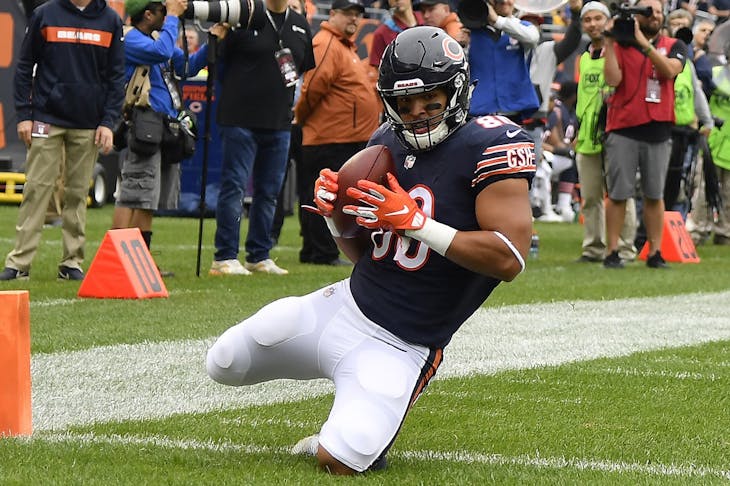
Photo: Imagn Images
The NFL Draft is two months old and the 2018 fantasy football season is right around the corner. One of the big advantages of Footballguys.com is a large database of staff rankings. This series looks at the difference between the collaborative Footballguys staff rankings and myfantasyleague.com positional ADP (Average Draft Position) at the skill positions. In this edition: tight ends.
tight endS TO TARGET
- TE4 Ranking
- TE6 ADP
- Why: Olsen had a lost 2017 season with an injury, limited to seven games and less than 200 yards. However, Olsen has been the featured element for Carolina the three years prior with more than 1,000 yards each season and 16 total touchdowns. The good news is Olsen returned to his featured status late in 2017 to the tune of 27 targets over the final three games.
- TE9 Ranking
- TE14 ADP
- Why: Like Greg Olsen, Reed is seeing a discount for a 2017 injury (and a deeper injury history for Reed). Reed has yet to play more than 14 games in a season and has missed 14 games over the last two years. The risk is obvious with Reed, but he has been one of the better tight end performers on a per-game basis in his career. The Washington passing game is up in the air Josh Doctson an unknown, Jamison Crowder the de facto lead receiver (103 targets) from a year ago, and Paul Richardson Jr the notable free agent (or rookie) addition. Reed's biggest concern is his health (rehabbing from toe surgery this offseason) but is an auto-start for fantasy when healthy historically.
- TE10 Ranking
- TE15 ADP
- Why: Doyle was a top-10 fantasy performer in 2017 even without Andrew Luck. The wide receiver depth chart is largely unchanged with T.Y. Hilton and a bunch of question marks behind him. Doyle has the addition of Eric Ebron to the tight end rotation, but Ebron has been a habitual underachiever to-date in his career. Doyle lacks ideal athleticism for the position, but with a lack of target competition and the upside of Andrew Luck raising the tide of the entire offense, Doyle is a no-brainer at TE2 fantasy cost.
- TE12 Ranking
- TE23 ADP
- Why: Brate returns to Tampa Bay despite the Buccaneers drafting O.J. Howard last offseason in the first round. Brate has been outstanding down the seam in contested catch situations and especially in the red zone with his connection to Jameis Winston. Tampa Bay has an uncertain WR2 situation after Mike Evans, leaving targets for the strong tight end depth chart. Brate has finished in the top-8 of the position each of the last two seasons with a whopping 14 touchdowns. Even with a downturn, Brate is a strong value at an ADP outside the top-20.
- TE22 Ranking
- TE33 ADP
- Why: Cook has been a limited ceiling fantasy option in his career (yet to finish in the top-10), but the floor has been solid as a committee option. The Raiders are taking shots on Jordy Nelson (physical erosion in his 30s) and Martavis Bryant (raw), but the wide receiver depth chart is far from stacked considering Amari Cooper has still yet to hit his expected ceiling considering his draft pedigree.
tight endS TO AVOID
- TE11 Ranking
- TE8 ADP
- Why: Burton is a major projection considering his TE1 ADP and 63 career receptions over four seasons. Burton has yet to be a starting tight end in the NFL and the Bears brought in not only Burton, but high-profile free agent Allen Robinson, second-round draft pick Anthony Miller, and have Kevin White returning from injury at a previously starved wide receiver depth chart in 2017. While the Bears have targets available from last season in passing game personnel turnover, to justify a TE1 price, there also needs to be a rising tide uptick for the Chicago offense overall, hinging on quarterback Mitch Trubisky.
- TE27 Ranking
- TE12 ADP
- Why: Evan Engram is the rare rookie exception for tight end production. Gesicki is viewed as the 2018 rookie with the most wide-open depth chart to produce early. However, Gesicki is a build-up athlete who struggled to consistently separate in college. Gesicki would need at least 80 targets to hit his ADP in addition to bucking a strong historical trend of rookie tight ends slow to produce at a meaningful clip.
- TE29 Ranking
- TE17 ADP
- Why: Round 1 rookie tight ends are sturdy long-term investments to produce at least one TE1 season. The short-term outlook is tremendously weak, however, as Round 1 tight ends only hit even the top-24 in Year 1 in the 35% range with top-12 down in the 10-15% zone. Hurst also has competition from Mark Andrews, an elite metric prospect also drafted by Baltimore in Round 3, the rare same position double-up by an NFL team at tight end in the early rounds.
- TE45 Ranking
- TE27 ADP
- Why: The biggest risk with Gates is he has yet to sign with an NFL team. The assumption would be reuniting with the Chargers as Hunter Henry is out for the year with an ACL injury. Even if Gates does sign with the Chargers, he fell off a cliff last year with less than 20 yards-per-game for the first time in his long career as his athleticism fades to a halt. Gates would be a touchdown threat only and a tenuous start any given week considering the Chargers depth at wide receiver.
Photos provided by Imagn Images
Tags
TE
strategy
Mark Andrews
Cameron Brate
Martavis Bryant
Jared Cook
Amari Cooper
Jamison Crowder
Josh Doctson
Jack Doyle
Eric Ebron
Evan Engram
Mike Evans
Mike Gesicki
Hunter Henry
T.Y. Hilton
O.J. Howard
Hayden Hurst
Anthony Miller
Allen Robinson II
Kevin White
Jameis Winston

_png)